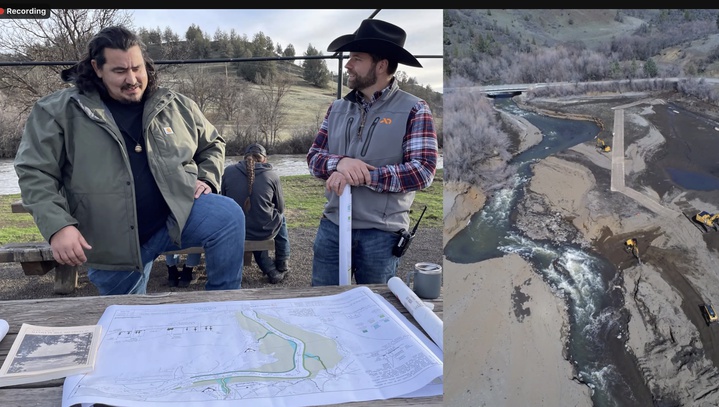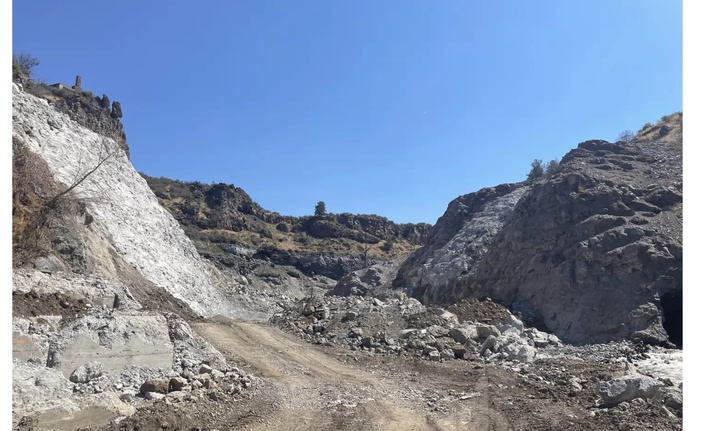Jessica Cejnar Andrews / Thursday, July 25, 2024 @ 5:08 p.m. / Environment, Infrastructure
Though Klamath River Dam Deconstruction Is Nearly Finished, Habitat Restoration Work Continues

Yurok Tribal Councilman Frankie Myers and RES staff inspect habitat restoration along the Klamath River following dam removal. | screenshot
As the deconstruction portion of dam removal on the Klamath River winds down, the nonprofit spearheading the effort is on track to achieve fish passage by the end of next month, a representative said.
Meanwhile, the firm tasked with habitat restoration in partnership with the tribes that have relied on the river since time immemorial, will fly several hundred large trees into the area via helicopter in August. Those trees, with their root wads intact, will be placed in fish-bearing streams for salmon and steelhead.
But for the Yurok Tribe, removing the four dams — JC Boyle, Iron Gate, Copco No. 1 and No. 2 — is part of a larger vision to fix the entire Klamath River basin.
“That is to provide landscape-scale ecosystem restoration on a scale that’s visible from space,” senior fisheries biologist Mike Belchik said. “Something that you can see that will change the map and change the future of the Klamath River Basin. It’s very exciting to be part of this, and dam removal was an absolutely essential part of this strategy.”
Belchik, who has worked on dam removal and water-related issues for the Yurok Tribe, participated in a press conference hosted by the Klamath River Renewal Corporation on Thursday.
The Zoom event sought to provide an update on habitat restoration following dam removal with Ren Brownell, KRRC public information officer, showing pictures of what’s left of the four dams.
KRRC took over ownership of those dams from PacifiCorp in late 2022 and spent much of last year preparing for reservoir drawdown and deconstruction.
The deconstruction process began with Copco No. 2 late last year since it was one of the smaller dams. KRRC drained the reservoirs slowly in an effort to protect downstream communities and to avoid releasing a large amount of accumulated sediment into the system — specifically dead algae.
Brownell said that KRRC began draining the reservoirs in January and February, a time when few salmonids would be in the river, according to Yurok Fisheries biologists.
“The fall run had already come up and spawned out and the juveniles had not yet out-migrated,” she said. “That was the ideal time and we also had higher winter flows to assist with sediment evacuation.”

What's left of Copco No. 2, one of four dams removed from the Klamath River. | Screenshot
The next step, now that deconstruction is almost finished, is to break the cofferdams that had funneled water into the various diversion tunnels used during the process, Brownell said.
“That will likely happen the first week of August in the case of those dams [Copco No. 1 and JC Boyle],” she said. “Iron Gate is much larger than the other two [with] a lot more material to move, so we’re looking closer to late August for that dam.”
Though the area looked bleak when drawdown began, by the spring, poppies, fiddlenecks, lupin and other native species began to carpet the newly-exposed land, said Dan Chase, director of fisheries, aquatics and design for Resource Environmental Solutions. A vegetation restoration lead from the Yurok Tribe said he counted six different species of butterflies and bees in just a few minutes — species that would not have been there if the land was still submerged under the reservoir, Chase said.
Resource Environmental Solutions, or RES, worked with the Yurok Tribe, including its construction company, on revegetation work and tributary restoration. RES is also working with the Karuk Tribe on fisheries and water quality monitoring on 240 miles of river, Chase said.
The revegetation effort incorporated 66,000 pounds of native plant seeds, 78,000 trees and shrubs and 27,000 acorns.
That revegetation will stabilize residual reservoir sediment, Chase said. Salmonids use that sediment, sand and cobblestones, he said. Sediment transport is also important since it benefits other aquatic species in addition to salmon and steelhead.
Sediment is a concern for Del Norte County leaders. At a Board of Supervisors meeting Tuesday, District 3 representative Chris Howard said he has attended meetings facilitated through California Natural Resources Secretary Wade Crowfoot.
Concerned about potential impacts to infrastructure at the Crescent City Harbor, Del Norte County had negotiated a mitigation agreement with KRRC, Howard said. However, sediment flows earlier in the winter heavily impacted the Dungeness crab fishery, Howard said.
“In following up with a lot of the commercial fishermen, they were pulling up traps with dead animals in them essentially,” he said.
Because there was debate with the state over whether sediment from the Klamath River flows north or south, Howard said the county was able to negotiate a process “where we would put equipment in the ocean to measure bathymetric data.”
“It’s a sounding-sonar type system that measures increases in sediments on the ocean floor,” Howard said. “I’m very eager to follow up with our consultant that we hired for the process, which was additionally funded with state funds to monitor that equipment to see how those impacts from this new release has impacted not only our harbor, but the area out in front of the harbor.”
On Thursday, Belchik said that the high turbidity that occurred at the mouth of the Klamath River earlier in the year wasn’t associated with dam removal, but rather an atmospheric river on Jan. 13.
KRRC, after negotiating an MOU with Del Norte County in 2021, created a sediment monitoring program for the continental shelf, Belchik said. That has been implemented at a cost of more than $1 million, he said.
“The Klamath River, by the time it gets down to the mouth, is so much larger than it is up near the dams,” Belchik said. “Even though the sediment load [near the dams] is significant, it pales in comparison to the total sediment load of a large-scale river like the Klamath.”
According to Belchik, large scale restoration projects are planned above the dams as well as in the lower Klamath River. He said the Yurok and Karuk tribes received more than $18 million to implement such projects
Those projects include exploring a large scale reconnection of Lower Klamath Lake to benefit suckers, salmon and waterfowl and to improve water quality. Belchik said the Yurok Tribe is working with the Klamath Drainage District, an irrigation district, on that project.
The Yurok and Karuk tribes are also with Klamath Tribes and Ducks Unlimited on projects associated with the Williamson and Sprague rivers above Upper Klamath Lake, Belchik said.
As for fish health, Toz Soto, fisheries program manager for the Karuk Tribe, said there was an increase in the spring of Ceratonova shasta, a parasite that is fatal to salmonids. But water temperatures were cool so there wasn’t much of an impact on fish.
“The fish looked really good,” said Soto, whose team works with the U.S. Fish and Wildlife Service to monitor fish health and abundance as well as out-migration timing. “That’s good news that we’re seeing healthy fish.”
Because of cooler water temperatures in the spring, there were few clinical signs of disease in fish, Soto said. Currently, the river’s been at about 79 degrees Fahrenheit, above the threshold for juvenile salmonids, “so we don’t expect to have fish in the river right now,” he said.
There are native suckers and other aquatic species more acclimated to warm water, however, he said.
Soto pointed out that the Karuk Tribe has been working to remove the four hydroelectric dams for about 30 years. He and his staff are currently “laser focused” on restoring the spring chinook run, which has been reduced to less than 100 fish on the Salmon River, one of the Klamath’s tributaries.
That population continues to decline, Soto said. Dam removal and restoring access to the cold water behind those dams is key to resilience in that salmon population, he said. The Karuk Tribe is working on understanding that run’s population dynamics and genetic structure, so when they’re reintroduced “we’re starting off with the right type of fish.”
“The loss of spring chinook salmon is also a loss of fishing techniques, ceremony, and things like that,” he said. “Dam removal represents not only the restoration of the fishery and the river, but also a lot of cultural aspects that were lost with not having these salmon runs and not having the river connected.”
CLICK TO MANAGE